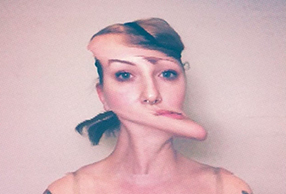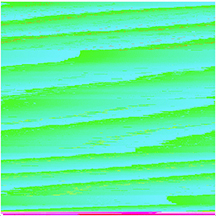By Elizabeth Merino Assistant Arts & Entertainment Editor
Perfection. It’s strived for, it’s slaved over and worked at again and again. It’s pushed in classes, in work places and in family life. With looming deadlines and the pressure of outside forces, reaching perfection can be a daunting, excruciating task. But what if we chose not to focus on perfection?
Self-proclaimed perfectionist and official visual designer at Code and Theory, Sierra True Siemer Jr., opened “Apophenia: Chance/Error/Design” this past Tuesday in Rosenberg Gallery located in Calkins Hall. Instead of focusing on her fixation, she turned to the often overlooked beauty in imperfection.
Apophenia is deriving patterns where they don’t truly exist. Siemer took the term for her own work, attributing artistic meaning from meaningless information on her computer screen.
Walking in, the viewer is immediately greeted with a large Apple computer, an ode to our technology-enhanced life. It connects to a projector that enlarges a looping video of Siemer constructing different expressions.
The expressions are engrossing; her eyes immediately latch onto yours as her face warps from a simple stare to lopsided ears and half-bent cheekbones.
The designer’s changing face attacks the notion of perfection.
Though slightly grotesque, her gaze is still piercing. In the screen’s display of glitches it gives off the pain of attempting to fit into a certain mold.
Like the video, in life people may feel as if they are not enough. In their efforts to be something they are not, they may become jumbled and out of whack, like the data Siemer reconstructed in this work.
Eventually she becomes indistinguishable, becoming so out of focus and grainy that she doesn’t even seem like a person anymore.
The gallery itself is simple. Previously blank white walls are now clad in 36 squares, 18 on either side.
Different-hued blocks, outlined in white and entitled “colors.gif,” covered the left side of the gallery.
Splattered with a cold frost blue and speckled with lines of sunset orange, the first square jumped out at me.
The color itself is a mistake, as most of the gallery is intended to be. But instead of looking like the error it is, it looks like whatever the viewer wants.
The square appeared to be like the Alaskan skyline. Wild with no inhibitions and only open air the best aspect of it is the glitch itself. It is whatever you want it to be, just as Siemer manipulated the mistakes for her own artistic ends.
The exhibit is reminiscent of Dadaism. It has no real structure, which in turn means it has no real limit. It’s nonsense, like the work of earlier Dadaists, and it purposely has no profound meaning other than to be seen and extract a reaction.
The opposing wall did just that; it incited a reaction. The “color.gifs” are juxtaposed with black and white framed stills of patterns and spots. This was a bit more random than the colors and felt almost ugly. The prints made me dizzy, like when people wear bad zebra pants or vertical stripes on a skirt. Other images appeared to be frozen video game backgrounds from a Nintendo 64. Siemer zoomed in and out of one photo, taking different screenshots.
Unlike her other works in the gallery, the black and white abstractions are aesthetically displeasing. I found no meaning in them and it was the only aspect not in tune with the Dadaist method.
The other pieces, though minimal, kept me thinking. The only thought that the black and whites provoked was the minute I spent looking at them was wasted.
Siemer pushes boundaries with “Apophenia,” exploring a new form of Dadaism through it. Though the black and white component wasn’t my favorite, overall the exhibit refreshing. It was simple, it was clean and it turned nothing into something. That is the core of what art really is.




